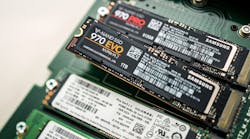PCIe 4.0 is the Next Big Thing in Solid-State Drives
What you’ll learn:
- Why are solid-state drives giving hard disks a run for the money?
- What’s the difference between and internal SSD and external SSD?
- How will PCIe fuel the SSD industry?
- Why is 3D NAND technology seen as the future of SSDs?
Companies pursuing revenue synergies are emphasizing innovative and new optimization technology engineered into solid-state drives (SSDs) to streamline workloads as well as meet customer needs amid unprecedented growth in performance and capacity.
With solid-state technology becoming more affordable, customers and manufacturers are counting on SSDs for light power usage, speed, and small footprint. While the hard drive isn’t dead by any means, solid-state storage has gradually gone mainstream. SSDs have made their mark in smartphones, laptops, computers, and tablets.
It hasn’t been easy for solid-state drive industry to thrive due to the tough competition from hard drives. Going by past trends, SSDs have grappled with downsides such as exorbitant cost with too little capacity. Of late, though, SSDs have become less expensive with price-per-gigabyte decreasing every year. That said, the price of HDDs has declined rapidly over the past decades, too.
Nonetheless, storage buyers are looking beyond the price-per-gigabyte matrix and showing an inclination toward SSDs, which should fulfill the demands of most computers. With a massive amount of consumer data being stored or backed up in the cloud, SSDs have become a desirable alternative to HDD storage.
SSDs vs. HDDs
Companies and customers are gravitating to SSDs due the more reliable, quieter, and faster technology. SSDs can boot up to full functionality at much faster rate than devices using HDDs.
SSDs weigh less and use half the power of HDDs. Smartphones and tablets have cashed in on the power efficiency and compactness of SSDs. Technological advances have made SSDs even more alluring as stakeholders continue to show traction for state-of-the-art storage.
SSDs hold an edge over HDDs in terms of being lighter, smaller, and having no moving parts. Thus, they produce less heat and consume less power. On top of that, they offer more capacity and reliability:
- Reliability: Current-generation SSDs are more durable and greater endurance. They’re warranted to store data uncorrupted and their smaller sizes make them attractive in the electronics and semiconductor industries.
- Performance: SSDs tend to boost application load times and retrieve data faster than HDDs. Specifically, they have instantaneous data-transfer speeds and eradicate any lagging.
- Storage capacity: Over the years, storage capacities in solid state drives have soared drastically. SSDs over 2 TB and below 2 B have expanded their penetration in the electronics arena.
Internal SSD or External SSD?
Portable and internal SSDs have steadily increased in speed and become more affordable. Internal SSDs are connected within a computer using SATA or PCIe connections. Portable external SSDs are employed for additional storage and data backup; they’re not integral to the computer’s boot-up sequence.
Internal SSDs are faster than their external counterparts—external drives often have lower bandwidth speeds because they’re connected to computers through an external USB. Internal SSDs maintain a larger bandwidth and can transfer more data thanks to SATA and PCIe interfaces.
Serial ATA (SATA) Technology Still Holds Prominence
Though the SATA interface was developed for hard drives, SSDs banked on the interface so that customers could easily upgrade their storage drive. Several SSDs have adopted SATA; it’s become popular in industrial applications and consumer devices in a slew of designs and sizes.
SATA-based SSDs are well-suited for customers who don’t want to outlay the high costs for the fastest storage, but instead are looking for latency and good performance features. It’s worth noting that PCIe-based SSDs have superior interface speeds compared to SATA-based SSDs.
PCIe Sets the Trend
PCI Express (PCIe)-based storage is gaining traction in performance-sensitive applications and in-memory workloads, including machine learning. And PCIe-based SSDs are the go-to interface for those demanding the fastest performance and lowest latency, becoming a popular option in data analytics and high-performance rendering.
PCIe SSDs have propelled advances in computing applications, including graphics processing units (GPUs) for 3D video. While PCIe 3.0 has an edge over SATA, PCIe 4.0—spurred on by the Non-Volatile Memory Express (NVMe) specification— has also come to the forefront.
NVMe (also referred to as the Non-Volatile Memory Host Controller Interface Specification), using the PCIe protocol, has the potential to outperform SATA in terms of speed. More organizations and content creators are turning to NVMe because the read and write speeds of NAND technology and a PCIe connection with SSDs make storage 4X faster than a SATA SSD.
With its impressive bandwidth and double the throughput of PCIe 3.0, PCIe 4.0 leverages faster data transmission between the SSD and the PCIe. The two-fold rise in bandwidth is mainly attributed to low-loss dielectric materials and new PCIe 4.0 controllers.
In May 2020, Samsung reported that it’s manufacturing an SSD with full PCIe Gen 4 support, focusing on the production efficiencies of its sixth-generation, three-bit V-NAND. Capacities may span from 960 GB to 7.68 TB.
ADATA rolled out new PCIe Gen3×4 M.2 2280 SSD in August 2020 to help bolster performance and reliability. ADATA’s Falcon offers 3D NAND capabilities to boost reliability and efficiency, ranging from 256 GB to 2 TB.
Another company making the HDD-to-SDD transition is Micron Technology with its new Micron SATA SSD based on advanced QLC NAND technology.
Sunil Kumar Jha is a Content Writer for Global Market Insights Inc.
